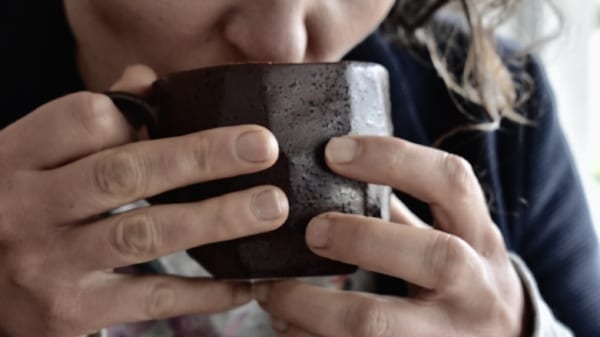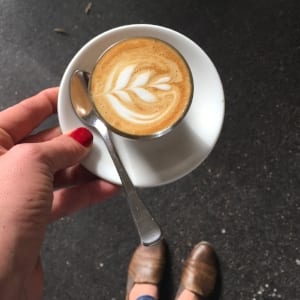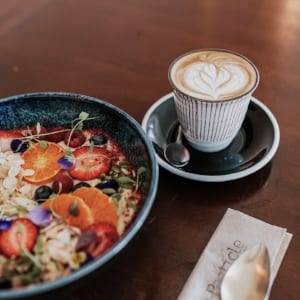





Read. Brew. Taste. Repeat.


The Zest Blog – By Mandy DelVecchio
Taste…
Colloids in my coffee.
When did next-gen nut mylks become an appealing alternative?
2014: I had a soy latte, it wasn’t the first time I tried to do such a thing, but this time I didn’t swear it would be my last.
2004: Almost a decade earlier when I was a devout vegetarian, leaning toward a fully plant-based diet I ordered a soy latte in a wholefoods café.
Bad move. After being served up a coagulated, cloudy, ‘wrong tasting’ drink I quickly switched instead to drinking my coffee black and swore I’d never do that to my coffee again.
As a coffee enthusiast going black wasn’t a bad move, black being the best way to taste the more delicate characteristics of a coffee, especially the lighter roasts that at the time were rising in popularity. So as my zest for coffee developed I said goodbye to milky brews.
The unfortunate thing was, although I wasn’t missing out on anything from the coffee itself, sometimes a creamy, comforting, sweet latte or cappuccino will only do – you know what I mean? But, while I wasn’t drinking dairy milk, and without being partied to the death of a perfectly innocent espresso shot by drowning it in the claggy, gritty soy alternative that was on offer at the time, I was reduced (excuse the obvious satire) to being satisfied with black coffee – and it was a long time again before I dove into a silky latte.
Update: I never became vegan, but I do now drink non-dairy lattes.
(Cut back again to) 2014: From my first soy latte to my 2nd (10 years later) the popularity of soy in coffee as an alternative to dairy milk had been fast growing.
The years rolled on and Melburnians got more health and socially conscious, and a lot more cafes offered soy lattes as a standard alternative to dairy. Despite Melbourne’s sass delivering the unfortunate stigma of a soy latte, they were still in demand, so cafes were forced to seek out a better option for soy than the old clumpy/watery So Good. (Not to mention specific names *wink)
Thankfully, coinciding with rise of specialty coffee baristas were becoming scientists and consumers experts, and as a pleasant byproduct of this a clumpy soy latte was no longer acceptable (was it really ever tho?)
Soon it was common knowledge among the soy latte sect – drinkers and makers alike – that the optimum heating for a non ‘scrambled egg’ textured soy milk was 65degrees or lower, also widespread was the fact the lighter roasts (producing more acidity) were not friends with soy milk. The non-dairy milk latte evolution was finally moving in a confident way.
So now we know 2 things. To put it simply (and don’t quote me, because science is never simple), acid and heat make ‘globs’ in soy lattes. While there are many other variables at play (because science) in the production of colloids – a homogeneous non-crystalline substance consisting of large molecules or ultramicroscopic particles of one substance dispersed through a second substance –these are largely the two determining factors.
2017: And today, we are thankfully over the teething period of‘alternative’ milks, and the quiet tug-of-war (from both sides of the fence) between baristas, and non-dairy latte drinkers seems to have subsided.
The result? Everybody knows how to use them, consume them, order them, serve them. And we can now look at the coffee itself and further producing roasts that work well with these non-dairy alternatives. As well, the makers – café owners, baristas – are able to have a little more fun with these options. A positive for coffee.
Take Zach, from Particle Cinnamon in Avondale Heights as an example of a positive. Zach makes all of his own plant-based mylks on site, fresh daily. As well as the main players, soy, coconut and almond, Zach also offers housemade mylks made from cashew, brazil nut and macadamia. Cashew mylk is so creamy when heated it actually produces a lusted after microfoam, in fact, Zach is so confident of his cashew mylk that he has put his mylk where his mouth is. Particle Cinnamon is hosting a “Alternate Mylk Latte Art Smackdown” at the Avondale Heights vegan café in October. Imagine that?
This has been a quiet evolution and a good one – for vegans and Melbourne baristas especially. Zach (and others) are keen to promote to skilled baristas just how far the movement has come, and increase the use of plant-based mylk in mainstream cafes. Because, now we are all a little more educated, why not?
And the premium blend they use at Particle Cinnamon? Our award-winning Blackbird Espressist , of course. A rich blend (Colombia, Ethiopia, Brazil) with the Colombian being the darker more complex component, it still has a floral nose and sweetness (greatly from the Ethiopian Sidamo) that doesn’t get lost (or lumpy) when nut mylks are poured.
Blackbird isn’t the only blend that works well with plant-based mylk, today there are a great variety of roasts that are ‘friends with soy’. Add to that the advancement of the mylks themselves and the shared knowledge between coffee industry professionals and consumers, and I would say we have finally reached a happy equilibrium between the two, thus creating an appealing alternative to dairy milk lattes.
While there are still those out there not so nuts about lattes, at least we have put to bed the fear of clouds in our coffees for those willing to seek out dairy alternatives. Hooray for progress.
And, just so you know, I am still not vegan, but knowing a bad latte isn’t in the way, it may still be on the cards.